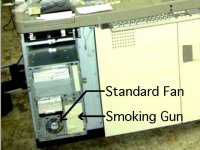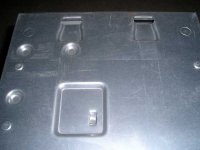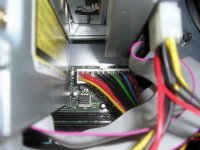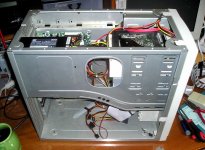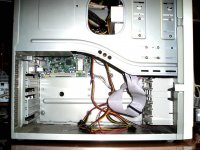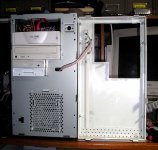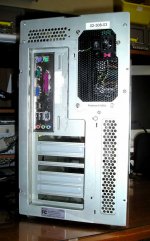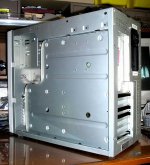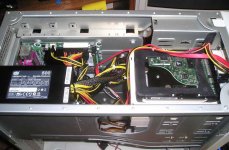Just learning that Intel's early ATX spec really had mixed ISA/PCI slot provisions was an interesting tidbit that came my way from research for this thread.
Uhm... An ISA slot has the same case requirements as a PCI slot, IE, the slot cover height, screw location, and the dimensions of the "tail" on the lower end are are all identical; "AT" form-factor cases dating all the way back to the IBM AT (heck, back to the IBM XT, which other than mounting hole locations is essentially the same as the "Baby AT" form factor) have no problem accommodating PCI boards when fitted with a motherboard bearing the slots. The only difference is that when viewed from above (pick up the card by the bracket and hold it so you're looking at the top with bracket facing towards you) an ISA board is mounted "right-handed"-ly on the bracket while a PCI card is "left-handed". This helps guard against someone being stupid enough to try to cram a PCI board into an ISA slot; they can't because the connector won't line up. This is something the case doesn't need to care about and has nothing to do with ATX.
(Not saying that Intel might not have mentioned it in their ATX proposal, but I'm sure they were talking about board-level concerns, not the case.)
I've never had, butalways wanted a Drawbridge Case, but that 7200 thing strikes me as a very elegant piece of sheet metal design. But it's almost totally ruined by the clever but incredibly chintzy little breakaway plastic supports and that pair of retention tabs that just don't quite live up to the promise of the overall concept.
Earlier in this discussion I threw out that comment about how sometimes "Cheap/Generic" clone cases are "better" than brand-name cases if your measure for "better" is "ruggedness". Things like Apple's PCI PowerMac cases are exactly what I was talking about. The designs are very clever and ergonomic and whatever but they're complicated composite structures that if damaged (by accident or compromised by ageing of their plastic parts) can come across as shabby and flimsy. By comparison there's not much to go wrong with a simple stamped-and-folded metal chassis as long as the manufacturer didn't skimp too much on the gauge of steel.
You know, the ones with midriff bulge and handles sticking out every which way.

Great example of the above: Nicely designed and ergonomic, but also scratch, accident, and crack-prone. (Apple really oversold the durability of those polycarbonate plastic panels and handles.)
Anyway, working further backwards:
It just seems odd that you'd put so much effort and thought into what we found out was a version of a PC case crammed inside a piece of industrial equipment (*snip*)
What makes even that particular spice free case special to me is that it's a breeze to stuff it with all kinds of random crap just for the hell of it . . .
You could have done this with the retail version of this case. (*snip*)
If such offends you or any others, mea friggin' culpa . . .
I was just confused by the continued insistence that it was something special and that it had to have been used for something like CHRP platform development.
It's a nice case, I don't think anybody will say otherwise. It was just... really strong insistence that it was involved in prototyping that was odd.
Ditto to all this. I have to say, Trash... your enthusiasm is great and all, but...
BTW, I never once claimed my case was a prototype of any kind, see title, it was a question.
If you read back over this you're really splitting hairs trying to say you *didn't* claim it was a prototype. In response to every comment saying "it just looks like a regular old PC case to me" you *really* went overboard in trying to find things about it that made it "special", and further insisting that any and all evidence of it being special *could only* translate to it having once lived inside an amazing super-secret computer lab, and, going even further, because it happened to have a mismatched hunk of an Apple case associated with it it obviously *MUST* have been something related to CHRP or something.
(I'm sure you'll reply in the negative, and you may well be telling the truth, but are you absolutely sure *you* didn't shove that tray in there and subsequently forgot about it? You certainly make it sound at least like you've been absolutely swimming in random Mac bits-and-pieces for years, I can't help but think that might be how it ended up in there. You said you bought this thing years ago, right? Shoving the tray in there and forgetting about it is something I might do.)
Extraordinary claims require extraordinary evidence. I guess you can to some degree claim victory in being correct that the case was "special" because it was indeed modified for a specific purpose, but you were so absolutely *specific* in your claims about its specialness that, well... it fails the "reasonability" test.
If by this . . .
. . . you mean by a "standard ExcelBox," then damn betcha!
That's my notion of any non-plastic, Vanilla Clone sheet metal made after about 1998...
So, here's the thing: your notion was wrong and you went totally to the mat refusing to believe it. (It's interesting that you can't believe that there might be people on this board who've seen the insides of more generic PCs from that era than you have.) Yes, that Enlight case might be made of sturdier stuff than that cheaper box but I'm sure 99%+ of them
ended up as "standard ExcelBox"es too. I had that exact case, just like a few hundred thousand other people did, and, well... it was "born" in late 1999-ish, dual booted Linux and Windows-something (the latter used exclusively for playing Half-Life and other games) and was a completely normal desktop workstation for a few years. I passed it down whole in 2003 to someone who needed a computer, in part because I'd already determined that the case was too cramped/had insufficient cooling to be useful for upgrades much beyond the (overclocked) dual 400mhz Celeron board it housed since new. There's nothing magic about it. At all.
(I recall paying some small premium, $20-$30 or so, to get that Enlight case over the *really generic* case when I bought that Dual Celeron system. That's what some slightly clever drive bays and a couple tenths of a millimetre thicker steel were worth. Not much in the grand scheme of things.)
The manufacturer of those photo-processing machines undoubtedly picked it because it *was* so popular (IE, easily sourced), reasonably well-made, and of the right physical size to fit the space in their machine. It is interesting that the manual for the machine talks about the different specs they packed in there; I wonder if the sideways fan mod was a necessity because they discovered the same thing I did: the case was fine for CPUs up to the Pentium III ballpark but started getting too toasty when fitted with a Pentium IV. Perhaps it was cheaper/easier for them to fab the sideways fan bracket and cut holes then it would have been to find another case to fit the same spot so they stuck with the 7101 even when it wasn't strictly the best choice anymore.
In any case, there's no pixey-dust stuck to that case that's going to grant amazing industrial superpowers to whatever you put in it just because it happened to have a "cooler" purpose than playing endless games of Windows Solitaire in its original incarnation. It's just a chunk of obsolete steel. That would still apply even if it *had* been a prototype of some sort too, I guess, but I suppose bringing that up begs the question... so what if it *had* lived in a lab and had once housed some super-awesome-amazing Quantum SuperDupercooled 128 bit PowerPC CHRP2000 prototype board? Without the provenance to prove it (let alone the amazing super-board itself) you still have nothing. "I bought it from a thrift store in a town that has computer companies in it" doesn't cut it if you're looking for your million dollar lottery winner.
Exploring the timelines and possibilities of its having been used for development, possibly even prototyping CHRP was instructional, good exercise for the imagination and a lot of fun, especially gorgonops's good natured, witty and educational snarkism.
*Snark*
It was fun and all, I guess, but eventually it gets on one's nerves trying to prove a negative. Oh well.



